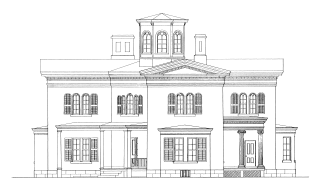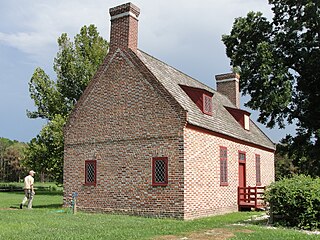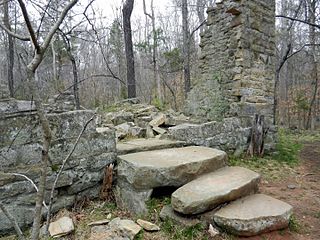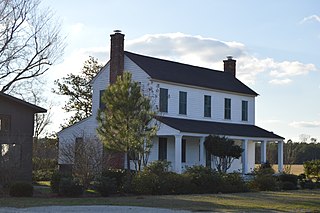
Somerset Place is a former plantation near Creswell in Washington County, North Carolina, along the northern shore of Lake Phelps, and now a State Historic Site that belongs to the North Carolina Department of Natural and Cultural Resources. Somerset Place operated as a plantation from 1785 until 1865. Before the end of the American Civil War, Somerset Place had become one of the Upper South's largest plantations.

Cooleemee, also known as the Cooleemee Plantation House, is a house located between Mocksville and Lexington, North Carolina, at the terminus of SR 1812 on the Yadkin River in Davie County, North Carolina. It is a U.S. National Historic Landmark, designated in 1978 for its architecture.

Stagville Plantation is located in Durham County, North Carolina. With buildings constructed from the late 18th century to the mid-19th century, Stagville was part of one of the largest plantation complexes in the American South. The entire complex was owned by the Bennehan, Mantack and Cameron families; it comprised roughly 30,000 acres (120 km2) and was home to almost 900 enslaved African Americans in 1860.

The Mordecai House, built in 1785, is a registered historical landmark and museum in Raleigh, North Carolina that is the centerpiece of Mordecai Historic Park, adjacent to the Historic Oakwood neighborhood. It is the oldest residence in Raleigh on its original foundation. In addition to the house, the Park includes the birthplace and childhood home of President Andrew Johnson, the Ellen Mordecai Garden, the Badger-Iredell Law Office, Allen Kitchen and St. Mark's Chapel, a popular site for weddings. It is located in the Mordecai Place Historic District.

The Carson House is a historic house and museum located in Marion, North Carolina. It was the home of Col. John Carson, and served as the McDowell County courthouse when the county was first organized in 1842.

Historic Oakwood is a neighborhood in downtown Raleigh, North Carolina, United States, on the National Register of Historic Places, and known for its Historic Oakwood Cemetery, its many Victorian houses and its location close to the Mordecai Plantation Manor. Located near the State Capitol and St. Augustine's Chapel, during the 19th century Historic Oakwood was home to prominent members of Raleigh's society. It is North Carolina's largest, intact 19th Century residential neighborhood and Raleigh's earliest white middle-class suburb. Unlike later suburbs, it developed lot-by-lot over time, instead of by platted sections. Its Victorian-era architectural styles include Second Empire, Queen Anne, and Italianate. Later infill brought the bungalow, the American Foursquare, American Craftsman style, and the Minimal Traditional house to the area.

This is a list of the National Register of Historic Places listings in Jasper County, South Carolina.

Newbold–White House is a historic house in Hertford, Perquimans County, North Carolina.

Warrenton is a town in, and the county seat of, Warren County, North Carolina, United States. The population was 862 at the 2010 census. Warrenton, now served by U.S. routes 158 and 401, was founded in 1779. It became one of the wealthiest towns in the state from 1840 to 1860, being a trading center of an area of rich tobacco and cotton plantations. It has a large stock of historic architecture buildings. More than 90 percent of its buildings are listed in the National Register of Historic Places and its National Historic District encompasses nearly half its area.

The Midway Plantation House and Outbuildings are a set of historic buildings constructed in the mid-19th century in present-day Knightdale, Wake County, North Carolina, as part of a forced-labor farm.
Oakland Plantation, also known as Lloyd Farm and the Elks Lodge, is a historic plantation house located at Tarboro, Edgecombe County, North Carolina. The frame dwelling dates to the mid-19th century, and consists of a two-story central section with flanking one-story wings and a series of rear additions. It has shallow hip roofs with Italianate brackets and features a one-story porch of the distinctive Tarboro lattice type. By 1931, the dwelling was occupied as an Elks Lodge for the African-American population.
White Oak Plantation, also known as the William Johnston House, is a historic plantation house located near Charlotte, Mecklenburg County, North Carolina. It was built about 1792, and is a two-story, Catawba River Valley School style brick dwelling. The original Quaker plan interior has been converted to a center hall plan. It has a gable roof overhang and a full-width, two-story gabled porch. It was built by William Johnston, a captain in the North Carolina militia at the Battle of King's Mountain in 1780.

Robinson Rock House Ruin and Plantation Site, also known as Site 31MK272, is a historic archaeological site located in Reedy Creek Park at Charlotte, Mecklenburg County, North Carolina. It is the remnants of an 18th-century stone dwelling of the Colonial period. The Robinson Stone House was probably built between 1780 and 1810. In September, 1979, the site was acquired by the City of Charlotte to be incorporated into a new park and nature preserve.

Sutton-Newby House is a historic plantation house located near Hertford, Perquimans County, North Carolina. It was built about 1745, and is a 1+1⁄2-story, four-bay, frame dwelling with a brick end and gable roof. It originally had both ends in brick. It features a full-width, shed roofed front porch and massive double-shouldered chimney. It is a member of the small group of 18th century frame houses with brick ends in northeast North Carolina; the group includes the Myers-White House and the Old Brick House.

Green River Plantation is a historic plantation house on over 360 acres located near Columbus, Polk County, North Carolina. The oldest section of the "Big House" was built between the years 1804–1807, and is a two-story, four-bay, Late Federal style frame dwelling. A later two-story, four-bay, brick Greek Revival style dwelling was built beside the original structure in the mid-19th century. The two sections were joined in the late 19th century by a two-story section and grand staircase to form a structure that is over 10,000 square feet in size and boasts over 42 rooms and spaces. The plantation house was built by Joseph McDowell Carson, son of Col. John Carson, who built Carson House at Marion, North Carolina. The later-built section of the home was the residence of Samuel Price Carson, North Carolina State Senator and U.S. Federal Representative, and younger brother of Joseph McDowell Carson.

Mills-Screven Plantation, also known as Hilltop, is a historic plantation house located near Tryon, Polk County, North Carolina. The main house was built about 1820 and later expanded into the 1840s, and is a long two-story, seven-bay, Federal / Greek Revival style frame dwelling. It features a two-tier, three-bay, pedimented Ionic order portico. Also on the property are the contributing stone springhouse, guesthouse part of which is said to have been a slave cabin, double pen log crib, and a larger 20th century frame barn.
High Rock Farm is a historic plantation house located in Rockingham County, North Carolina. It dates to the early-19th century, and is a two-story, central hall plan, Federal style brick dwelling with a rear ell. It sits on a full basement and has a hipped roof. The front facade features a pedimented portico supported by two stuccoed columns and with a gallery at the second level.

Pool Rock Plantation is a historic plantation house located near Williamsboro, Vance County, North Carolina. It consists of two, two-story sections. The older was built in 1757 by James Mitchell, an immigrant from Lunenburg County, Virginia. His daughter, Amy Mitchell, married Michael Satterwhite in the house in 1759. It is a two-story, three-bay, Federal style frame structure. It forms the rear section. About 1855, a more ornate two-story, three-bay, Italianate style frame structure attributed to Jacob W. Holt (1811-1880). The later section has a shallow hipped roof and overhanging eaves. The two sections are joined by a two-story hallway linker. Also on the property is a contributing one-story, hip roof office building.

Mordecai Place Historic District is a historic neighborhood and national historic district located at Raleigh, North Carolina. The district encompasses 182 contributing buildings and 1 contributing object in the most architecturally varied of Raleigh's early-20th century suburbs for the white middle-class. Mordecai Place was listed on the National Register of Historic Places in February 1998, with a boundary increase in 2000.

Black Rock Plantation House, also known as the Allen-Love House, is a historic plantation house located near Riegelwood, Columbus County, North Carolina. It was built about 1845, and is a two-story, five-bay, braced frame I-house with Federal / Greek Revival style interior design elements. The house is sheathed in weatherboard and has a gable roof. It has a rear shed roof addition and a replacement one-story shed roofed front porch. The house was renovated in 2013.




















